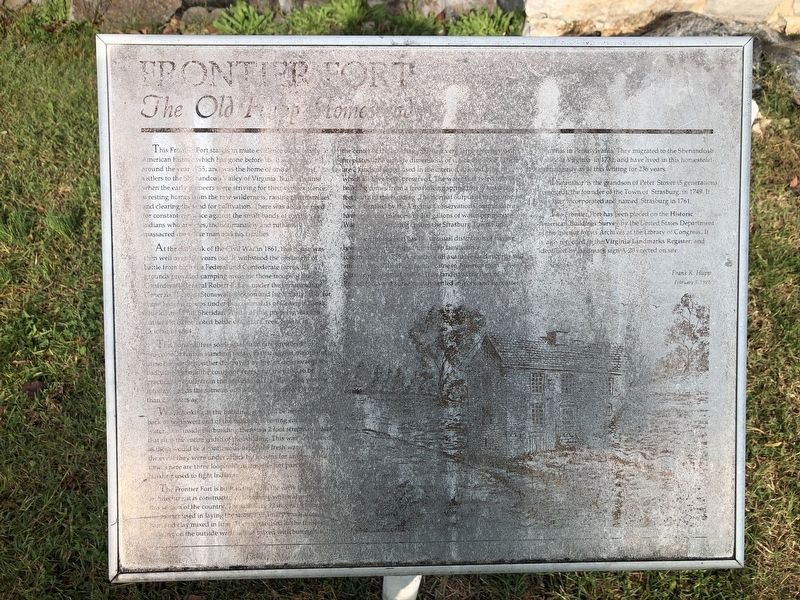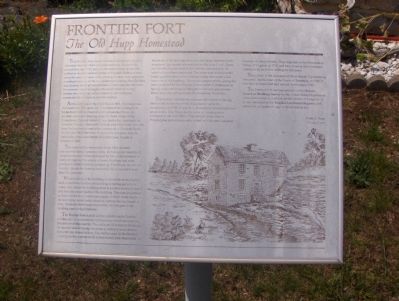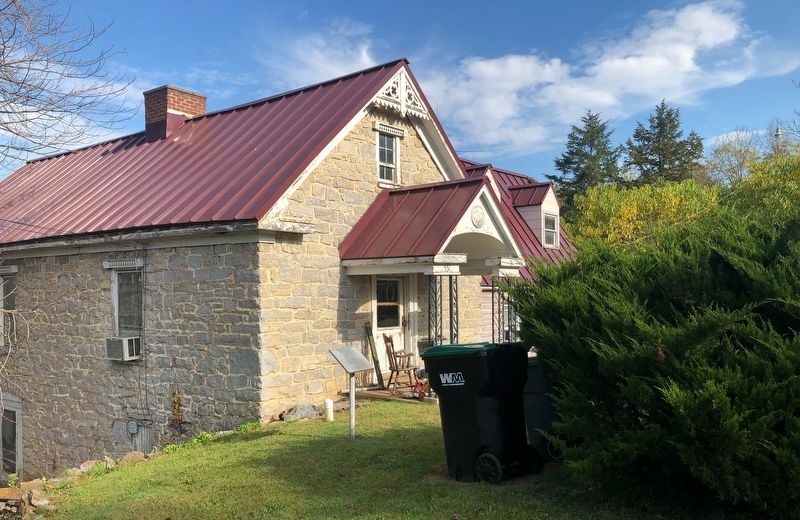Strasburg in Shenandoah County, Virginia — The American South (Mid-Atlantic)
Frontier Fort
The Old Hupp Homestead
This Frontier Fort stands in mute evidence of that early American history that has gone before us. It was built around the year 1755, and it was home of one of the first settlers to the Shenandoah Valley of Virginia. Built at a time when the early pioneers were striving for their very existence, wresting homes from the raw wilderness, raising their families and clearing the land for cultivation. There was also the need for constant vigilance against the small bands of roving Indians who at times, indiscriminately and ruthlessly massacred the white man and his families.
At the outbreak of the Civil War in 1861, this house was then well over 100 years old. It withstood the onslaught of battle from both the Federal and Confederate forces. Its grounds provided camping areas for those troops of the Confederate General Robert E. Lee, under the commands of Generals Thomas (Stonewall) Jackson and Jubal Early, also for those Federal troops under the commands of Generals Banks, Shields and Phill Sheridan. A part of this property was the battlefield in the noted battle of Cedar Creek fought in October of 1864.
The home differs somewhat from other restored pre-colonial homes standing today, in that a great majority of these homes were either destroyed by fire, or deteriorated so badly throughout the course of years, that they had to be practically rebuilt from the ground up. This house, as you see it today, stands the same as one would have viewed it more than 236 years ago.
When looking at the house, it would be noted that the back or northwest end of the building is resting entirely in water, also, inside the building there is a 2 foot stream of water that runs the entire width of the building. This was so planned that there would be a continuous supply of fresh water inside, in the event they were under attack by Indians for any length of time. There are three loopholes in this, the fort part of the building used to fight Indians.
The Frontier Fort is built in line with the early German architecture, it is constructed in limestone which abounds in this section of the country. The walls are 22 inches in thickness. The mortar used in laying the stone is ordinary mud, animal hair, and clay mixed in lime. The mortar used in the finished pointing on the outside walls is lime mixed with buttermilk. In the center of the building there is a very large chimney (with fireplaces), the outside dimensions of which are 5’ by 8’. There are 2 kinds of wood used in the interior, oak and pine, of which all have been preserved. The water that is fed into the building comes from a free flowing spring that is just a few feet north of the building. The normal output of this spring has been

Photographed By Devry Becker Jones (CC0), October 23, 2020
2. Frontier Fort Marker
Unfortunately the marker has weathered heavily.
The Frontier Fort has the unusual distinction of having been in the ownership of the Hupp family since its construction in 1755. A search of all available land records will attest to this. The Hupp family came to America from Germany in the mid 1600’s. They landed at the Port of Philadelphia and subsequently settled in York and Lancaster Counties in Pennsylvania. They migrated to the Shenandoah Valley of Virginia in 1732 and have lived in the homestead continuously as of this writing for 236 years.
The author is the grandson of Peter Stover (5 generations removed), the founder of the Town of Strasburg, in 1749. It was later incorporated and named Strasburg in 1761.
The Frontier Fort has been placed on the Historic American Buildings Survey by the United States Department of the Interior for its Archives at the Library of Congress. It is also recorded in the Virginia Landmarks Register, and identified by landmark sign A-20 erected on the site.
Erected 1991 by Frank R. Hupp.
Topics. This historical marker is listed in these topic lists: Colonial Era • Forts and Castles
Location. 38° 59.684′ N, 78° 21.337′ W. Marker is in Strasburg, Virginia, in Shenandoah County. Marker is at the intersection of N. Massanutten Street (U.S. 11) and Cold Spring Road, on the right when traveling south on N. Massanutten Street. Touch for map. Marker is at or near this postal address: 551 N Massanutten Street, Strasburg VA 22657, United States of America. Touch for directions.
Other nearby markers. At least 5 other markers are within walking distance of this marker. A different marker also named Frontier Fort (here, next to this marker); Banks’ Fort (approx. 0.2 miles away); American Legion (approx. 0.4 miles away); Historic Strasburg (approx. 0.4 miles away); Stonewall's Surprise (approx. 0.4 miles away). Touch for a list and map of all markers in Strasburg.
More about this marker. It is directly in front of the house described.
Also see . . . Hupp House. Virginia Department of Historic Resources website entry (Submitted on November 10, 2007, by Craig Swain of Leesburg, Virginia.)
Credits. This page was last revised on June 13, 2022. It was originally submitted on November 2, 2006, by Roger Dean Meyer of Yankton, South Dakota. This page has been viewed 3,773 times since then and 52 times this year. Photos: 1. submitted on November 2, 2006, by Roger Dean Meyer of Yankton, South Dakota. 2, 3. submitted on October 24, 2020, by Devry Becker Jones of Washington, District of Columbia. • J. J. Prats was the editor who published this page.

